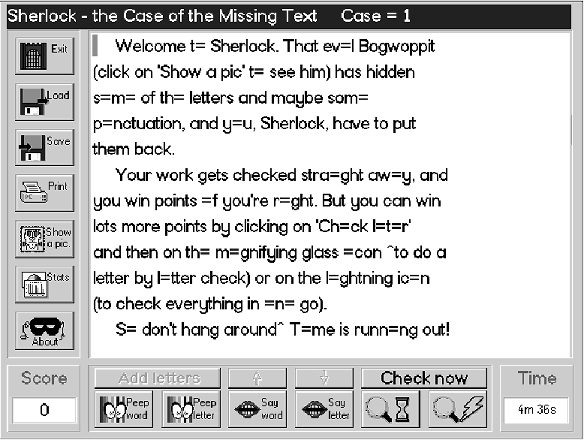
Bob Fox
University College Worcester
b.fox@worc.ac.uk
This article first appeared in MAPE Focus on Literacy Autumn 1998
Over the years, much has been written about the educational value of Developing Tray (or Tray, or Infant Tray, or Intro Tray, or DevTray, or other derivatives and clones) in helping children to develop effective reading strategies. However, in my experience at least, its actual classroom use has been rather patchy and sporadic, and pupil outcomes have often been a bit disappointing. The problem, I think, is two-fold.
Firstly, it is not a very 'sophisticated' piece of software - versions of it have been around since the early days of the BBC B, there are no smart graphics or animations or noises, and it looks rather limited in its scope, so some teachers probably write it off as out of date.
Secondly, to be used to maximum effect, it needs a teacher or other informed adult in fairly close proximity, which is a luxury many classrooms do not often afford, and it works best when activities are planned and tailored to pupils' needs, which makes it a non-starter in classrooms where the computer is used primarily as a reward for having completed the 'real' work.
The coming of the literacy hour, with an increased emphasis on direct interactive teaching in whole classes or groups, provides an excellent opportunity to bring the idea to the fore once again. Briefly, for those who have never seen or used a version of the program before, the idea is that children work on a block of text rather like an extended 'hangman' game, inserting letters in place of blanks, and gradually revealing the text as a whole - rather like a photographer's developing tray, in which a photograph gradually becomes clear. Users can employ a range of strategies, including the use of phonic knowledge and contextual cues, and there are obvious opportunities for social learning when the task is undertaken collaboratively, and for focused and relevant teacher- pupil interaction within a literacy hour context. The starting text can vary from nothing but a set of dashes (or whatever) to a mostly completed text with a few missing letters. Letters can be 'bought' to expedite the process. Some versions, including the original, have complex scoring systems, though in my experience these often complicate and confuse the task unnecessarily.
For Archimedes users, there is a remarkably straightforward and simple version of Tray available from SEMERC. It uses standard text files (created in a text editor like !Edit, which is built into the machine), so creating your own files is simplicity itself. You can also specify letters to be included when the text first appears on screen (but only in terms of the 'least frequent', which is a limitation), or, more profitably, you can save and re-load partially completed screens. The font, point size and colour of the text are configurable, and the appearance is considerably improved by the use of a high-resolution monitor. One small niggle I have is that in order to load a file the icon must be dragged to the Tray icon, and if you slightly miss, it opens as a normal text file within !Edit, thus giving the game away and revealing the answer.

Topologika have upgraded their Punctuate! program to operate as a fully configurable Tray-type program, Sherlock. Text can be created either in the program itself or in a text editor, and can be configured to one of three sizes. There are options to hide all text, all vowels, all consonants or all punctuation, or to hide random characters at a user-configurable interval. You can also list particular letter combinations (blends, digraphs, suffixes etc.) you wish to hide. There are various scoring options available, including no scoring at all, and also a speech facility and timer. Letters can be bought, or peeped at (if the option is configured), at a suitable cost if the scoring option is turned on. There is also the facility to save partially-completed text. Sherlock also has the capacity to incorporate foreign characters with accents.
The 40 example texts provided with Sherlock seem to me to be rather drill-and-practice and therefore slightly dull, but making your own text files is very simple and effective, and creative and imaginative teachers should have no difficulty in making resources for use with specific individuals, groups or even the whole class, if the children can be arranged so that they can all see the monitor.
Both programs can be used with children of any ability, across the whole of Key Stages 1 and 2 and beyond. Sherlock has a more robust feel to it than the current SEMERC Tray, but there is a place for either as a framework program in every classroom where the literacy hour is in operation.
Tray (Acorn Archimedes / A7000 etc.): £20.00 + VAT site
licence. Available from:
Granada Learning Ltd - SEMERC,
Granada Television, Quay Street, Manchester M60 9EA
Tel. 0161 827 2929
Ffax 0161 827 2966
Sherlock (Acorn Archimedes/A7000 etc., or PC Windows
3.1/Win '95/RM Window Box etc.) £35.00 + VAT single user; £70.00 + VAT site licence.
Available from:
Topologika Software,
Waterside House, Falmouth Road, PENRYN, Cornwall TR10 8BE
Ttel. 01326 377771
Fax 01326 376755